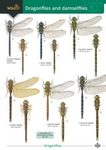Field / Identification Guide Identification Key
By: Klaas-Douwe B Dijkstra(Author), Asmus Schröter(Author), Richard Lewington(Illustrator)
336 pages, colour photos, 1000 colour illustrations, b/w illustrations, colour distribution maps
Fully revised, the second edition of this guide features updated taxonomic and distribution information, as well as five new species discovered since the first edition in 2006.
![Field Guide to the Dragonflies of Britain and Europe Field Guide to the Dragonflies of Britain and Europe]()
Click to have a closer look
About this book
Contents
Customer reviews
Biography
Related titles
About this book
The first edition of the Field Guide to the Dragonflies of Britain and Europe was a ground-breaking identification guide that led to an increase in Odonata recording across Europe. The second edition includes fully revised regional guides and identification texts, updated distribution maps and conservation statuses, illustrated accounts for five species that have been discovered in the region since the first edition, updated checklists and taxonomy, new photographs throughout, as well as an introduction to larvae identification. Each species is lavishly illustrated with artworks of males, females and variations, as well as close-ups of important characters.
Contents
- Introduction
- Studying dragonflies
- Dragonfly behaviour
- Dragonfly occurrence
- Habitat
- Flight season
- Dragonfly names
- Dragonfly identification
- Identification of suborders, families and genera
- Regional guide
- Identification
- Zygoptera
- Damselflies
- Anisoptera
- True Dragonflies
- Appendices
Customer Reviews
Biography
Klaas-Douwe 'KD' B Dijkstra developed an interest in natural history as a child living in Egypt. Here he made his first observations of dragonflies as a 12-year-old, having to invent his own scientific names for them because he had no literature. The discovery of the first Anax ephippiger in The Netherlands in 1995 incited an active involvement in Dutch dragonfly work. KD was a founding member of the Dutch society for odonatology in 1997, as editor of its journal Brachytron, and co-edited and co-authored the handbook of Dutch Odonata published in 2002. He obtained an MSc in biology at Leiden University in 1998, developing a passion for Africa during fieldwork in Uganda in 1995. As a research associate of the National Museum of Natural History Naturalis in The Netherlands, KD has worked on the systematics and biogeography of tropical African Odonata since 2001. In 2005, he shared the Worldwide Dragonfly Association outstanding achievement award for this work.
Over almost forty years, Richard Lewington has built up a reputation as one of Europe's finest wildlife illustrators. He first became interested in butterflies as a child when he inherited a cabinet of insects from his father. He studied graphic design at the Berkshire College of Art, and since leaving in 1971 has specialised in natural-history illustration. His meticulous paintings of insects and other wildlife are the mainstay of many of the modern classics of field-guide art, including Insects of Britain and Western Europe, Collins Butterfly Guide, Field Guide to Dragonflies of Britain & Europe, Field Guide to the Moths of Great Britain and Ireland, Pocket Guide to Butterflies of Britain and Ireland and Guide to Garden Wildlife. He was, for many years, the principal artist on the multi-volume series, The Moths and Butterflies of Great Britain and Ireland. He has also designed and illustrated wildlife stamps for a number of countries, including a set of ten stamps of British butterflies for Royal Mail in 2013.
Field / Identification Guide Identification Key
By: Klaas-Douwe B Dijkstra(Author), Asmus Schröter(Author), Richard Lewington(Illustrator)
336 pages, colour photos, 1000 colour illustrations, b/w illustrations, colour distribution maps
Fully revised, the second edition of this guide features updated taxonomic and distribution information, as well as five new species discovered since the first edition in 2006.




















































